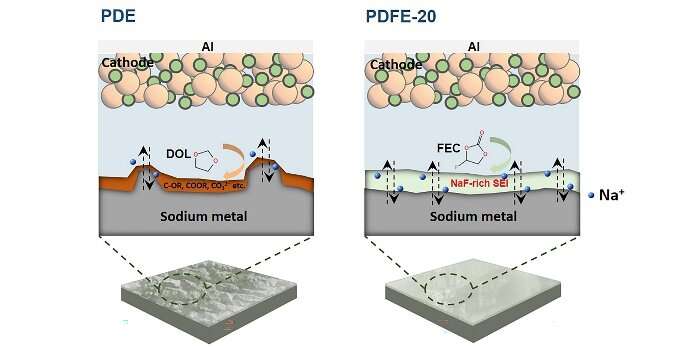Stable sodium anodes for sodium metal batteries

Sodium secondary batteries have a similar working principle to lithium secondary batteries but are low-cost and are expected to serve as a powerful supplement to lithium secondary batteries. Solid-state batteries offer high-safety and high-energy-density features, and are considered to have remarkable prospects. However, all-solid-state batteries are disadvantaged by their poor physical solid-solid interfacial contact and low ionic conductivity, which restrict their performance and hinder their short-term commercial applicability.
The use of in situ polymerization to prepare solid/quasi-solid electrolytes has been well-researched recently, and has enabled close interfacial contact between the electrolyte and electrodes. Many in situ polymerization systems have adopted a high-temperature free-radical polymerization strategy; however, maintaining high reaction temperatures in the long term is unfavorable to the performance of the battery.
1,3-Dioxolane (DOL) can be polymerized through cationically ring-opening reactions at room temperature to obtain poly(1,3-dioxolane) (PDOL), and has high research and application value. DOL has recently been successfully used in lithium metal/lithium sulfur batteries as an in situ polymerization monomer; however, there is little research concerning the application of PDOL in sodium metal batteries (SMBs).
In addition, although in situ polymerization strategies can greatly improve the physical contact between the electrolyte and electrodes, it remains challenging to maintain close interfacial contact during battery cycling considering the high reactivity of the Na metal anode.
Recently, Hongfa Xiang's group from the Hefei University of Technology and David Mitlin's group from the University of Texas in Austin published a manuscript entitled "Stable sodium anodes for sodium metal batteries (SMBs) enabled by in-situ formed quasi solid-state polymer electrolyte" in the Journal of Energy Chemistry. In this work, based on the interfacial protection strategy, fluoroethylene carbonate (FEC) was introduced into the PDOL system.
A PDOL-FEC quasi-solid electrolyte was prepared by the in situ polymerization method and successfully applied to SMBs. DOL continuously reacted with the highly chemically active Na metal anode, and the accumulation of reaction products led to a high interfacial resistance, which severely deteriorated the performance of the batteries. After the introduction of FEC, it was reduced at the Na metal anode side prior to DOL addition, forming a NaF-rich passivation layer and inhibiting further side reactions between DOL and the Na metal, and thus, effectively improving the overall performance of the batteries.
More information: Jian Ma et al, Stable sodium anodes for sodium metal batteries (SMBs) enabled by in-situ formed quasi solid-state polymer electrolyte, Journal of Energy Chemistry (2022). DOI: 10.1016/j.jechem.2022.09.040
Provided by Chinese Academy of Sciences





















